Believe me when I tell you from personal experience, that observing wild Komodo dragons from a few feet away gives you a whole new respect for the size and power of these giant lizards.
Komodo dragons can reproduce either sexually or by “virgin conception” depending on environmental conditions. In the wild they usually reproduce sexually, but females in captivity have been known to reproduce by parthenogenesis, without the need for sperm. Female Komodo dragons lay a clutch of 15 to 30 leathery shelled eggs in the nest. There is no maternal care of the young… in fact, they might eat their own young!
Key Reproductive Features
| Breeding interval | Breed once yearly, but females will often mate more than once to ensure eggs are fertilized |
| Breeding season | Breeding occurs from July to September |
| Range number of offspring | 30 (high) |
| Average number of offspring | 22 |
| Average gestation period | 8 months |
| Average age at sexual or reproductive maturity (female) | 9 years |
| Average age at sexual or reproductive maturity (male) | 10 years |
Source: AnAge Database of Animal Ageing and Longevity
Komodo Dragons are the Largest Reptiles on the Planet
A mature healthy male Komodo dragon can weigh over 150 lbs (70 kg) and reach over 10 feet (3 m) in length. Females reach sexual maturity at 8-10 years old when they weigh about 40 lbs (18 kg).
Komodo dragons are only found in one small corner of the world on four islands in Indonesia. According to UNESCO, there are about 1,700 dragons on Komodo island, with about 5,700 dragons in total spread across the islands of Komodo, Rinca, Gili Motong and parts of Flores.
Even though it is the largest reptile on the planet, Komodo dragons were not discovered by the Western world until 1910.
There’s not much known about the lifespan of Komodo dragons. Scientists believe that male Komodo dragons can live up to 62 years in the wild based on extrapolations from body size.
Why are male Komodo dragons much larger than the females?
Adult males are considerably larger because large body size is important for winning battles with other males and gaining access to females for breeding. The growth of adult females slows dramatically after sexual maturity, when they put much of their energy into reproduction. Males on the other hand continue to grow for several decades after sexual maturity.
Male Dragons Battle for the Right to Mate
Males keep track of females and their readiness to mate by smelling for pheromones with their giant forked tongues, by testing the air and licking. Females leave traces of their pheromones in their faeces and urine.
When a female is ready, dominant males will battle one another in dramatic and often bloody wrestling matches that can last for hours. When not deep in battle, males put on displays of dominance and aggression by hissing, expanding their throats, and thrashing their tails.
When males battle for females, they usually stand upright using their tails for support, trying to throw their opponents to the ground while grabbing each other with their forelegs and teeth. Once thrown to the ground, the loser either runs away or remains flattened in the dirt in a submissive pose.

Video: Males fighting for mating rights
Komodo dragons have the most amazing teeth and claws
Epic battles over females can often be bloody affairs because of the sharp teeth and immense claws. The teeth are like shark’s teeth, with a sharp serrated edge designed to slice open flesh.
Surprisingly, wounded males appear to be unaffected by the bacteria and venom of other dragons. Scientists are analyzing dragon blood to see if they have antibodies that provide immunity.
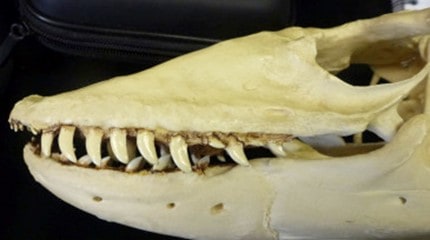
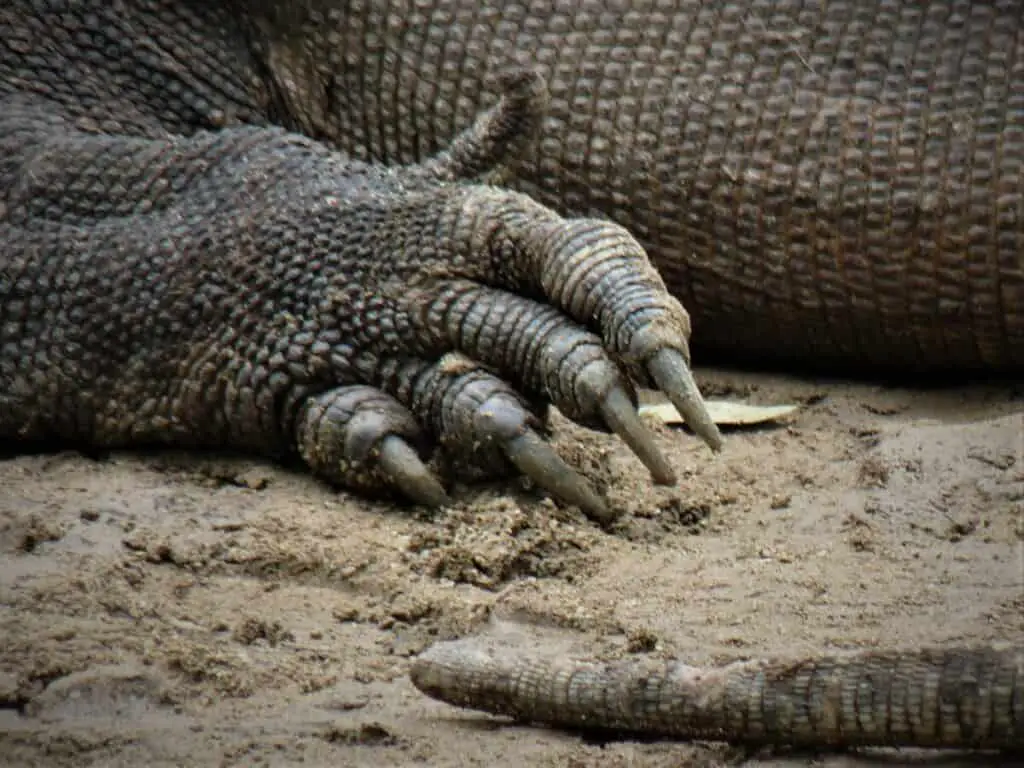
Is that giant lizard a male or a female?
Just so you know, it is difficult to determine the sex of a Komodo dragon.
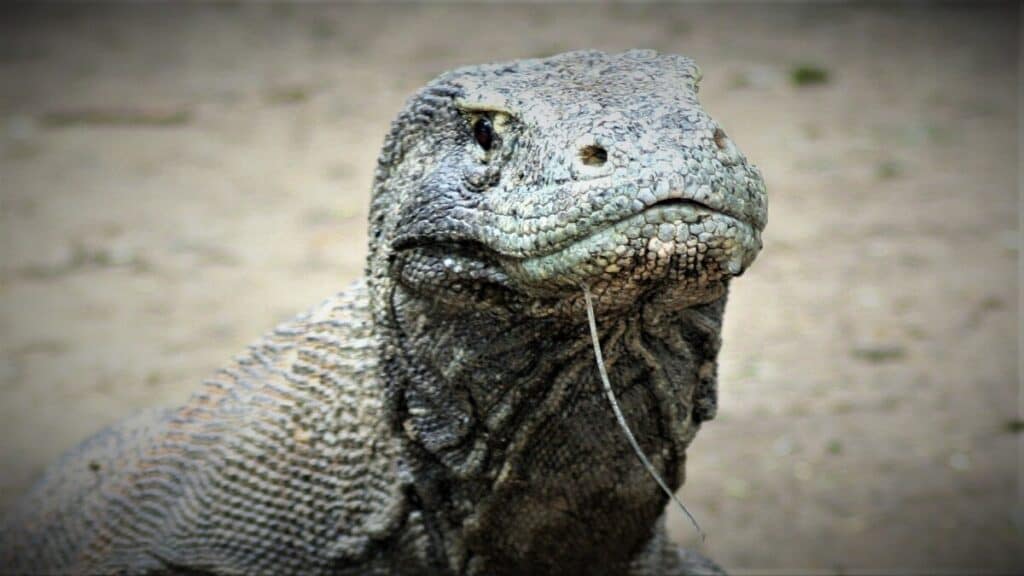
The first problem, of course, is getting close enough to the dragon! The second problem? There aren’t any obvious differences to distinguish between males and females. There is one slight difference in the arrangement of scales just in front of the female’s cloaca. I’m not speaking from personal experience, of course!
Mating typically occurs between May and August when the females are ready to mate.
The Forked Penis – Everything You Need to Know
You might be familiar with snakes and lizards having forked tongues, but did you know that male Komodo dragons have forked penises – or hemipenes? This is not as unusual as you might think since most lizards and snakes have hemipenes and they belong to the squamata, which is the second largest order of vertebrates with over 9000 species.
Why don’t they teach this stuff in school?! I always thought that having one penis was good enough. Not if you’re a dragon!
The two penises together are called hemipenes, while each one individually is called a hemipenis. Each hemipenis is associated with a single testis (testes is plural). The terminology alone is complicated!
Sperm produced in the right testis are ejaculated through the right hemipenis, and those produced on the left come out of the left. Easy peasy. There must be a children’s rhyme in there somewhere!
Looking at the next photo you’ll see that the hemipenis is not the most beautiful of body parts – unless you are a female dragon, I suppose. I don’t need to tell you that it is not easy to get a good look at a live male dragon’s hemipenis. So, the best I can do is this photo of a rather sad-looking preserved specimen.

When not in use, hemipenes are normally kept inside out in a pocket or fold at the base of the tail. During mating, one hemipenis or the other is everted – like unrolling a sock. Males have longer, thicker tails than females, because they need someplace to store their hemipenes.
If you would like to see a real live hemipenis it is probably a lot safer to take the following steps with a small snake or lizard, rather than trying to wrestle a full-grown male Komodo dragon onto its back.
From Wikipedia we learn that “Hemipenes can be examined on a living snake or lizard by gently squeezing on the tail and massaging towards the vent, which is the cloacal opening on the underside of the tail. This will cause the hemipenis to evert out of the body.”
Why do Komodo dragons have two penises?
It all begins with the female.
Female lizards can store perfectly viable sperm safely for up to five years and can choose when they use the sperm to fertilize their eggs. It is in the female’s interest to mate with as many males as possible to have enough sperm available to increase the likelihood of fertilization.
Females can even select which male’s sperm they want to use for insemination.
When the females become receptive, males need to be ready to make their move without delay. A big male lizard can potentially mate with more than one female once they successfully defeat the other males. Imagine the dilemma of having mated with the first female but then having to take a pause even while another female is ready to go. This is what scientists refer to as the refractory period. In the case of lizards, the refractory period can last for a few days.
There’s a good chance that female number two isn’t going to hang around waiting.
Male lizards don’t have to deal with this kind of a reproductive crisis, since they have a second penis handy for immediate duty! Big boy Komodo can just switch to his second hemipenis to inseminate a different female.
Did you know about the Cephalopod with the detachable penis? True story! Read my article on Octopus Sex!
Nest building and Egg laying
Females dig a nest up to 2.5 meters deep for their eggs. Egg laying normally occurs in August, and afterwards they will defend their nest until December. Nest-building and egg-laying requires a lot of energy and females lose quite a bit of weight in the process. Female Komodo dragons lay a clutch of 15 to 30 leathery shelled eggs in the nest. Incubation lasts 200 – 250 days and there’s no evidence of maternal care after hatching.
Once the young hatch, they are on their own and need to get into the trees as quickly as possible. At this vulnerable stage they have one main predator – other Komodo dragons!
Yes, the dragons are cannibals and will make short work of any youngsters found on the ground. Parents will eat their own young without hesitation.
Young dragons stick to the trees for the first few years of their lives.
When I was visiting Komodo island most of our attention was focused on the big adults in front of us. I was surprised when I turned around to see young dragons up in the trees with their attention focused on us! A five-foot-long dragon in a tree could still make life difficult for a person if they decided to take their chances on the ground.
How does Parthenogenesis Work?
Strictly speaking, parthenogenesis, or “virgin birth,” is not considered a form true asexual reproduction since it involves the production of egg cells.
The Komodo dragon is one of about 70 species (only 0.1%) of vertebrates that can have “virgin births.” With most reptiles in this category, this is their only method of reproduction. Not so for the Komodo dragon, females can switch between sexual reproduction and parthenogenesis.
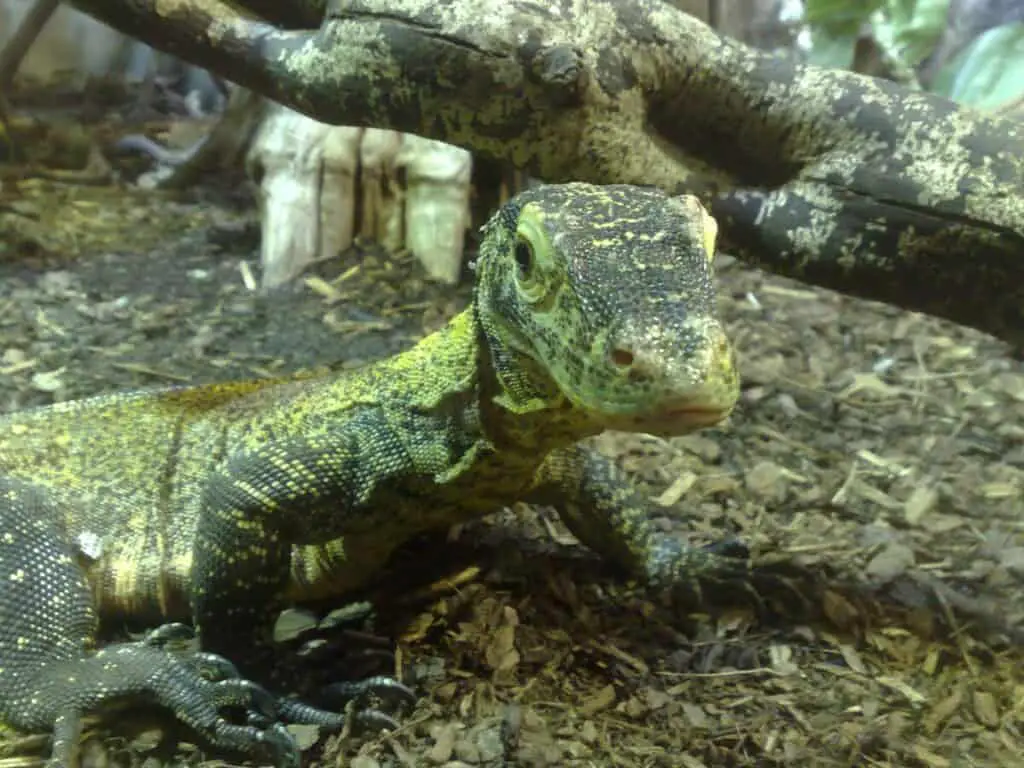
The tricky process of parthenogenesis explained
In one sentence: parthenogenesis takes place when a duplicate piece of DNA within an egg does the fertilization, rather than sperm, and it develops to maturity.
The biological process of making an egg cell, called oogenesis, produces four egg-progenitor cells, one of which becomes the egg while the other three typically get reabsorbed by the female’s body. In parthenogenesis, one of the extra cells, having duplicate DNA, acts like a surrogate sperm and fertilizes the egg cell.
This process results in offspring containing the same genetic material as their mother. The infant dragons, however, are not miniature clones of the mother. Even with only one parent, there is enough genetic shuffling taking place during the egg production stage to produce unique individual offspring.
Parthenogenesis in Komodo dragons first documented in 2006
In 2006, scientists in the UK reported that two captive Komodo dragons had given virgin births, one at Chester Zoo and one at London Zoo.
At the time, researchers speculated that female Komodo dragons could switch between sexual reproduction and parthenogenesis, as a way of effectively cloning themselves without the need for males. The young Komodo dragons that emerge from unfertilized eggs are all males.
Some species whiptail lizards never have sex, and every youngster is born by parthenogenesis. Males are not required for the propagation of the species and each one is female.
Parthenogenesis could enhance the ability of Komodo dragons to survive long term if needed as a back-up means of reproduction.
Theoretically, parthenogenesis could even allow these animals to stake a foothold on a new island. Say a female was swept across or swam to a new island (they are excellent swimmers) but found herself alone. She could lay a clutch of eggs without the need for a mate, but the young would all be males. Such a tiny gene pool would likely not be sustainable, but what if another female arrived? It raises some interesting scenarios.
Which raises the question: why do we need sex anyway?! Lucky for us males, humans are not capable of parthenogenesis.
Male dragons take their job seriously! A fun story
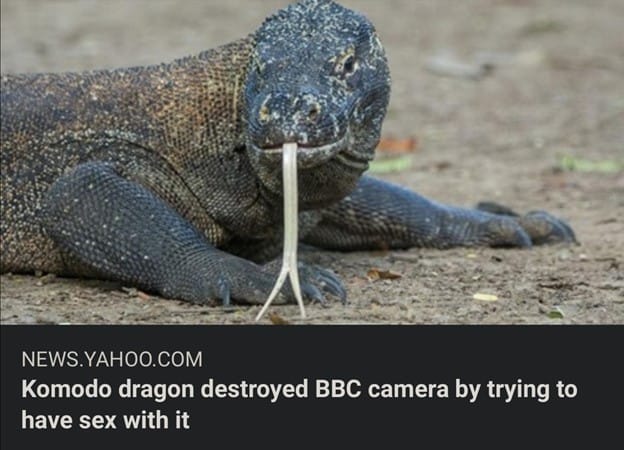
Have you heard about the komodo dragon that destroyed an expensive camera after trying to have sex?
OK, it’s not quite that simple: the crew had two cameras hidden inside life size imitation animals to catch footage for the BBC series Spy in the Wild 2. One was a life size imitation dummy of a female Komodo dragon and the other was a fake pig.
The male dragons tried to mate with the imitation female and became increasingly frustrated when the fake lizard did not respond. They took their frustrations out on the fake pig… with an expensive camera inside.
Executive producer John Downer described the scene, “With its massive claws this dragon starts raking at the skin of the ‘female’, and there’s nothing you can do because you can’t intervene. You just hope it will realise there’s something not right and it will stop.”
“But then this pig, with all our equipment in it, was in the wrong place at the wrong time and they just annihilated it.“
“It was breeding season and they’d been riled up by fighting over this female and testosterone gets the worst of us. They were like dinosaurs, it was just unbelievable, it was totally smashed to pieces.”
I can believe it. I’ve seen full-grown Komodo dragons up close in the wild and they are not to be messed with.
Check out my related article on visiting with Komodo Dragons in Komodo National Park.
Don’t worry, the Rangers have forked sticks to keep the Komodo dragons in line. Yeah, forked sticks! To control 10 foot long 150 lb lizards mixed in with a bunch of well-fed cruise ship passengers. Sounds like the plot for a good horror movie, doesn’t it?

Header feature image by Becker1999 on Flickr CC BY 2.0
References
A.C. Ferguson-Smith, in Encyclopedia of Genetics, 2001
See Our TOP Articles for More Fascinating Creatures
- How do Octopus Reproduce? (Cannibalistic Sex, Detachable Penis)
- How Smart are Octopuses? Are Octopuses As Intelligent as Dogs?
- Do Jellyfish have Brains? How Can they Hunt without Brains?
- Why are Deep Sea Fish So Weird and Ugly? Warning: Scary Pictures!
- Are Komodo Dragons Dangerous? Where Can you See Them?
- Koala Brains – Why Being Dumb Can Be Smart (Natural Selection)
- Why do Lions Have Manes? (Do Dark Manes Mean More Sex?)
- How Do Lions Communicate? (Why Do Lions Roar?)
- How Dangerous are Stonefish? Can You Die if You Step on One?
- What Do Animals Do When They Hibernate? How do they Survive?
- Leaf Cutter Ants – Surprising Facts and Adaptations; Pictures and Videos
- Irukandji Jellyfish Facts and Adaptations; Can They Kill You? Are they spreading?
- How to See MORE Wildlife in the Amazon: 10 Practical Tips
- Is it Safe to go on Safari with Africa’s Top Predators and Most Dangerous Animals?
- What to Do if You Encounter a Bullet Ant? World’s Most Painful Stinging Insect!
- How Do Anglerfish Mate? Endless Sex or Die Trying!
- How Smart are Crocodiles? Can They Cooperate, Communicate…Use Tools?
- How Can We Save Our Oceans? With Marine Sanctuaries!
- Why Are Male Birds More Colorful? Ins and Outs of Sexual Selection Made Easy!
- Why is the Cassowary the Most Dangerous Bird in the World? 10 Facts
- How Do African Elephants Create Their Own Habitat?
- What is Killing Our Resident Orcas? Endangered Killer Whales
- Why are Animals of the Galapagos Islands Unique?
- Where Can You See Wild Lemurs in Madagascar? One of the Best Places
- Where Can You see Lyrebirds in the Wild? the Blue Mountains, Australia
- Keeping Mason Bees as Pets
- Why do Flamingos have Bent Beaks and Feed Upside Down?
- Why are Hippos Dangerous? (Do They Attack People?)


